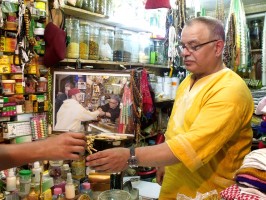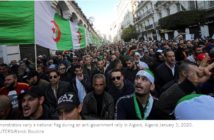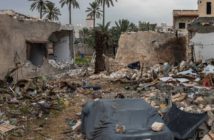ANTHROPOLOGY NEWS
M Chloe Mulderig
The Arab Spring led to regime change in multiple North African countries, but Morocco remained an exception. Small-scale demonstrations there in February 2011 hinted at potential unrest, yet less than two months later, one of Morocco’s most liberal French-language publications, TelQuel, published a cover of the king standing behind the throne with the headline “La Révolution C’est Moi” (“I Am the Revolution”). This bold statement would prove accurate: in June 2011, King Mohammad VI successfully put forward a new constitution overwhelmingly approved by the populace, satiated calls for democracy with only a superficial dilution of his power, and emerged in 2012 with more popular support than ever before.
During my fieldwork in Fes, Morocco throughout this time, the Arab Spring bloomed and subsequently withered. Ben Ali of Tunisia fled, Mubarak of Egypt faced trial, and Gaddafi of Libya was killed by his own people. The monarchies of the Arab world fared better: Kuwait bribed its citizens to pacify them; Jordan reorganized its economic classes to ensure stability; and Bahrain borrowed soldiers from neighboring Saudi Arabia to viciously crush demonstrations. Morocco, however, took a different path. Its charismatic king played upon the nation’s special historical tendencies to increase his popularity during this tumultuous time. This power of presence is a long-standing tradition in Morocco, re-imagined for the challenges of maintaining absolute power in the 21st century.
For centuries, traveling monarchical entourages allowed Moroccan leaders to assert military and economic dominance and to maintain the allegiances of Amazigh (Berber) tribesman and Tuareg desert-men. The king, with tens of thousands of servants and slaves, would establish camp and take meetings with local leaders for days or weeks at a time before packing up and moving to another location, leading to the Moroccan saying: “The king’s throne is his saddle, the sky his canopy.” This traveling court reinforced the ties between government and people through the use of bay’a: the pledge of loyalty Moroccans make to the makhzan.
Mohammad VI’s father had no interest in touring Morocco, preferring to remain in Rabat and Casablanca. Hassan II was notorious for avoiding rural towns and Amazigh regions, and his loathing of Amazigh culture was well known. Many Moroccans have commented, in person and in print, that if Hassan II were still king, Moroccans would be rebelling like the Libyans. Mohammad VI has not faced any such threats.
Mohammad VI has romanced the public using monarchical entourage since taking the throne in 1999. He has traveled to all corners of the country, including some of the Amazigh strongholds that had not seen anyone from the makhzan in person for decades. The crown prince was born in the Fes palace, and the king spent so much time in Tetuouan that rumors swirled that he was contemplating relocating the capital. Perhaps most significant for a king utilizing the traditional tools of authority, Mohammad VI broke with all Moroccan tradition and made his marriage public. His wife, Salma, regularly appears at his side and at her own events, and has become a central part of the monarchical entourage. For the first time, Moroccans are able to know their king as a leader, father, and husband, experiencing a modern sense of affinity.
Countries with free elections enjoy the public spectacle of politicians on tour, kissing babies and eating at local establishments. While Mohammad VI did not face the risks of re-election, he recognized the need for popular support in a time of unrest. His successful tours of the country intensified, winning the hearts and minds of his people one smile and one handshake at a time. Just as other autocrats in the region appeared painfully out-of-touch with the needs of their people, Mohammad VI exercised a power of presence that embraced his citizens on a very personal level.
Public Displays of Affection
The power of presence that seals the nature of bay’a has become the key to political stability in Morocco during the Arab Spring. The king personally traveled to the opening of women’s rehabilitation centers, solar power plants, and schools across the country throughout 2011 and 2012. Moroccans admired his work ethic, contrasting him to the “lazy” royals of the Gulf states. Men cheered at video footage of the king rooting for the national football team at World Cup qualifiers. Women swooned when the Moroccan runner-up in the international Arab Idol competition reported that the king personally called and thanked her for representing the nation with such talent.

A merchant of religious souvenirs in Fes conducts business in front of a candid photograph of King Mohammad VI. Photo courtesy M Chloe Mulderig
Images and reminders of the king can be found in every store, restaurant and public establishment, much like other authoritarian societies across the Arab world. But despite a popular set of official photographs being sold throughout the country, an increasing number of Moroccans are using personal photographs of the king. A date shop I frequent has a wall dedicated to pictures of Mohammad VI tasting dates and buying almonds in the shop, and its owner proudly points to himself shaking hands with the monarch. While Mohammad VI’s father limited his time to the French-constructed Villes Nouvelles of major cities, today’s king is known to wander for hours in the depths of the medinas of Fes, Salé, and Marrakesh, watching craftsmen work, listening to the stories of shopkeepers, and posing for countless photographs.
On April 28, 2011, members of Al Qaeda of the Islamic Maghreb (AQIM) detonated a bomb in the popular Argana cafe at the center of Marrakesh’s Djema al-Fna square. Seventeen were killed, with many Moroccan waiters and other staff injured. The next day, Mohammad VI arrived on the scene and television cameras captured the king in knee-high rubber boots walking through the rubble with inspectors. Footage of the king visiting victims in the hospital was shown on national television stations, and even I could barely hold my emotions in check when the king broke into tears at the bed of one young burn victim.
After Mohammad Bouazizi self-immolated in a hopeless rage in Tunisia in late 2010, President Ben Ali visited Bouazizi’s family and offered to pay all expenses. When he later reneged on this promise, many Tunisians cited it as a sign of his continuing hypocrisy and corruption. Morocco’s king made the same promise to the victims of the Marrakesh bombing but followed through, paying hospital bills and funeral expenses with personal checks. He vowed to catch the criminals that terrorized his nation, and within days, nine were arrested. Moroccans I chatted with asserted that the king had personally saved his people.
The king has repeatedly pledged his dedication to Moroccans worldwide, and has succeeded in exerting his power of presence outside the national borders. When Moroccan ex-pats in Blois, France sought the king’s financial support for a new mosque, Mohammad VI put his money where his mouth was, literally, by cutting a check for €787,000. Images of this personal check flooded Facebook and Moroccan blogs, and youth in particular applauded his efforts as the constitutionally recognized “commander of the faithful.” Mohammad VI’s personalizing of power created a constant public presence and reinforced what he called in his July 2012 Throne Speech “the depth of the long-lasting bond of the bay’a [and]… the people’s and the throne’s unwavering loyalty towards each other.”
The Moroccan people’s loyalty is no longer to the position of king, but to King Mohammad VI himself because of the personal connections he has crafted. Many in the global community, including US Secretary of State Hillary Clinton, have praised Mohammad VI for his political success during the past two years. Yet few have tried to understand how the king actually accomplished this uniquely Moroccan balancing act. By recognizing Morocco’s particular historical and cultural understandings of authority and legitimacy, the king was able to play up to his greatest strength—the power of his personal charisma.
M Chloe Mulderig is a PhD candidate at Boston University (degree anticipated in 2014). She is conducting her fieldwork in Fes, Morocco through 2012, focusing on young women’s understandings of Islam, individualism, and the nature of Islamic authority.






